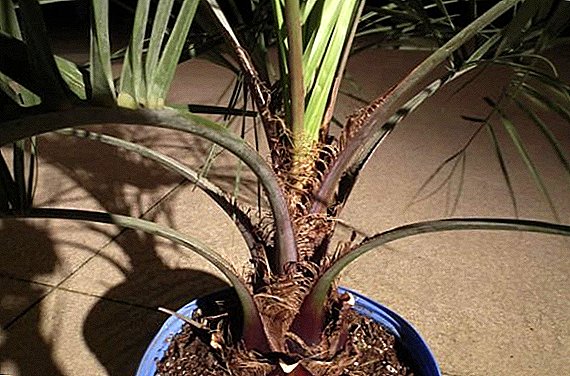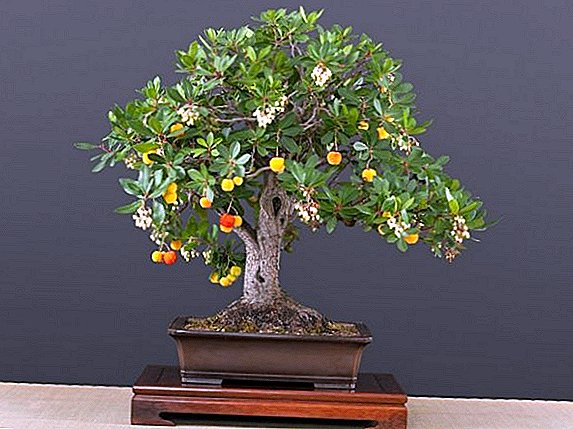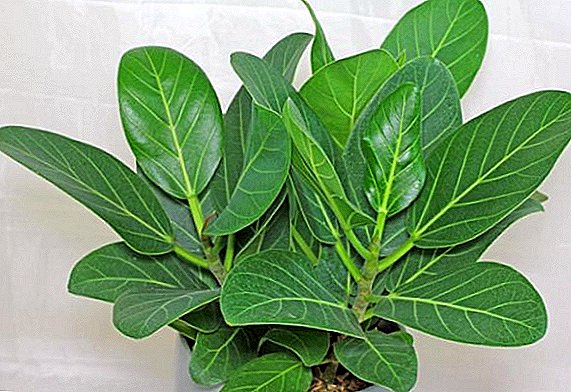 Not everyone can allow to have a real three-meter evergreen miracle in the house. But in the offices of these plants feel great and look luxurious. But at home you can grow banyan, if properly care for him. Today we look at how to take care of the ficus Bengal.
Not everyone can allow to have a real three-meter evergreen miracle in the house. But in the offices of these plants feel great and look luxurious. But at home you can grow banyan, if properly care for him. Today we look at how to take care of the ficus Bengal.
Botanical description and photo
The Bengal Ficus (Fícus benghalénsis) is a representative of the mulberry family. Under natural conditions it grows in regions such as Bangladesh, Sri Lanka and India. In nature, it can cover an area of several hundred square meters, and the crown of this plant can cover five hundred meters.
Did you know? At home, the ficus of Bengali is considered a symbol of eternity. They decided to decorate the temples and living quarters. And from the leaves make canopies and cover the roof.
How does the Bengal ficus
This tree is distinguished by a specific lifestyle, which is also called banyan. The initial stage of banyan formation is based on the emergence of a hanging root system on the powerful, horizontally growing branches. The roots are multiple, not covered with hairs. Their development is slow. After a certain time, most of the roots dry up and no longer touch the soil.

The remaining part of the air root complex still reaches the ground and can take root. As a result, the suspension part undergoes a stage of enhanced thickening and forms trunks.
Orange fruits growing on the tree are food for animals and birds, which turn into the main seed distributors and serve as assistants in plant reproduction.
Learn more about ficus such as the Benjamin Ficus, rubber and microcarp.
Banyan is very tall - up to 40 meters, and its crown can spread up to 610 m.
The leaves of the plant also stand out - up to 25 cm in length. Form - elliptical, oval, elongated. On the leathery surface there are juicy light green veins.

Flowering tree in the form of sycony.
The growth rate of the plant is considered one of the speed representatives of the flora, since the increase in the year is 60-100 cm.
Spread and homeland
The native places of the Bengal ficus are the jungle. Therefore, under natural conditions, it can be found in India, Thailand, Burma, Malaysia and southern China. The plant grows up and in breadth, taking possession of vast territories.

Banyan growth continues indefinitely, as young roots stretch to the ground, take root and form new trees.
At home, to reproduce this phenomenon is almost impossible. And those who have decided on such a step will have to make a lot of effort and stock up on stubbornness and a rather big room in which you will need to create a tropical climate.
How to choose a plant when buying
In order for the tree to please the hosts in the future and not to have problems in care, it is important to know the basic rules for choosing a plant:

- Do not buy ficus in the cold. Adaptation during this period is quite difficult.
- You can not choose large plants. The older the tree, the harder it is to adapt to new conditions.
- Healthy sprouts can be tested this way: shake gently and stroke against the leaves. If the leaves fall off (2 or more), then this tree is not worth taking.
- The roots of the plant should not be black or dark brown.
Important! In stores, ficus leaves can be processed with polishes. Therefore, these trees after the acquisition is better to rinse under the shower.
Where to place the Bengal ficus: conditions
Bengal Ficus is considered one of the most popular species of its kind, grown at home. However, most often this plant is cultivated in spacious offices and halls. After all, over the years of its development, even a room tree grows to the ceiling.
We share the secrets of successful cultivation of plants at home - achimenes, aspidistra, callas, crocuses, lithops, kalerii, hamedorei, euonymus, ruell, strawberry tree.
Lighting and location
Choosing the place where the ficus is supposed to be placed, should pay attention to the sunny side of the room. However, one should not allow the rays of the sun to fall on the leaves, because they can get burned. That is, the light should be bright, but diffused.

Ficus should be placed in the west or east side. If there is no such place, then shading will be required in the southern direction.
Air humidity and temperature
Fucus does not welcome temperature drops. For development in spring and summer, the plant will need a temperature of + 18-26 ° C, and in the fall and in the winter period - no less than + 17 ° C. If the tree is cold, it will begin to fold the leaves.
Important! Banyan trees do not tolerate drafts, so this point needs to be controlled.
Ficus needs moisture. The optimal level is 60-70%. To maintain the desired level, the leaf mass is sprayed once a week. In the cold season, when heating devices are working, spraying becomes especially important.

In addition, the leaves should be regularly wiped with a soft damp cloth or sponge, removing the accumulated dust. No extra will also be any additional ways to increase the humidity.
Soil for the plant
Ficus loves fertile, loose soil. You can buy ready-made mixture in the store, and you can prepare the mix yourself. It should include the following components:

- peat ground - 1 part;
- turf - 1 part;
- leaf earth - 1 part;
- sand - ½ part;
- charcoal (some).
The plant will feel good in a mixture of sod (1 part), sheet (1 part) of soil and sand.
Before planting, the soil (both purchased from the store and cooked) must be calcined in the oven. Such a procedure is necessary to prevent the spread of diseases and the destruction of pests.
The soil should be well drained. Expanded clay can be placed on the bottom.
Learn how to water your ficus at home.
Bengal ficus: care at home
That the tree had a worthy look, it is necessary to look after it competently. Knowing the individual subtleties, anyone can grow a beautiful exotic representative of flora at home.

How to water
It is necessary to water a ficus regularly and plentifully. Moisturize the soil as the top layer dries to a depth of 2-3 cm with soft warm water.. The procedure is repeated about once every 3-4 days.
Important! Ficus can not be poured, and the remaining water after 20-30 minutes should be drained from the pallet. Moisture stagnation is fraught with root decay and the development of fungal diseases.
The plant must be watered both in summer and in winter (once a week) - ficus does not have a pronounced rest period.
Than to fertilize
Feed the tree in the summer, during the period of active development, once every 2-3 weeks. To do this, you can use universal fertilizers in granules with a high nitrogen content. You can also use organic fertilizers.

In winter, the plant rests, so it should not be fertilized more often than once every two months. For this use top dressing for non-flowering plants.
Anyway, before fertilizing the fertilizer is pre-dissolved in water and only low concentration is used.
How to trim
One of the main procedures for the care of the plant. It allows you to give the tree a great decorative and compact form:
- spherical;
- in the form of a bush;
- multi-tiered;
- bonsai

You can also shape any sculpture.
Prune the plant in spring or early summer, observing these rules:
- the form must be natural;
- it is better to pre-guess how the tree will look after trimming;
- sterile instrument - the guarantee of health of ficus;
- the cut is performed at an angle to the edge.
Did you know? In ancient China, it was recommended to put a container with ficus in the bedroom. This plant tends not only to purify the air, but also to normalize sleep.
When and how to transplant
The first transplant of ficus is made immediately after purchase. If the plant has dropped the leaves, the procedure should be postponed for 10-14 days until the tree adapts to the new conditions.

The second and subsequent transplants are carried out in the spring. During this procedure, it is possible to form a crown and cut too large roots. With each transplant use new, larger than the previous 3-4 cm capacity.
We recommend that you familiarize yourself with the rules of ficus transplantation at home.
Do not transplant only adult figs, which grow in large containers. In this case, simply remove the top layer of soil and replace it with fresh.
Basic rules for transplantation:

- water;
- remove the top layer;
- remove the earthen room, slightly shake;
- transplant in a new pot;
- add fresh soil mixture.
Breeding features
Ficus Bengali breeds cuttings, leaves, air outlet.
When cutting, take the upper cuttings with foliage, which are slightly stiff.

After removing the milky sap from the site of the incision, the graft is placed in water, adding drugs to stimulate the growth of the roots (you can simply put it in the moistened sand in the bag). Capacity put in a warm, bright place. It takes several weeks for rooting to occur.
After the roots have developed, the stalk is transplanted into a separate pot and looked after later as an adult plant.
When breeding ficus has a few recommendations.:

- the optimum time of the year is spring-early summer;
- the cut is washed and the stock is dried;
- during cutting, young, not stiffened shoots cannot be used.
Did you know? The most legendary Bengal ficus has a crown of 350 meters and 3200 aerial roots. It looks more like a grove than a tree.
Plant Diseases and Pests
In case of detection of traces of pests, the tree is satisfied with a warm shower. If the ficus is rather large, then its foliage is thoroughly washed with a damp sponge, and then it is treated with chemical preparations (Aktillik, Tanrek, etc.).
Occasionally, thrips, scutes, or spider mites can appear on the ficus.
Although this is quite rare, it is still worthwhile to carefully examine the leaves of the plant.

Sick plant mainly as a result of improper care. Therefore, you need to know what signs can talk about:
- young plants wither leaves - the room is too cold;
- yellow spots appeared on the foliage - the result of excessive watering;
- brown spots on the edge of the leaves - the plant is hot, the humidity level has gone down, the fertilizer surplus;
- the stems are drawn out, and the size of the foliage becomes smaller - not enough light;
- growth slowed down, and leaves grew dull - time to fertilize the soil.
Reviews from the network














